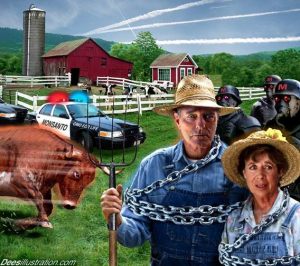Re-posted from The Complete Patient
 Tuesday, September 1, 2009 at 11:31PM
Tuesday, September 1, 2009 at 11:31PM I’ve been reading reports that the National Animal Identification System (NAIS) is in trouble. Its funding from Congress has been cut. The listening sessions around the country sponsored by the U.S. Department of Agriculture were nearly unanimous in opposition. Is there truth to such conjecture?
I’ve been reading reports that the National Animal Identification System (NAIS) is in trouble. Its funding from Congress has been cut. The listening sessions around the country sponsored by the U.S. Department of Agriculture were nearly unanimous in opposition. Is there truth to such conjecture?
Doreen Hannes, a Missouri farmer, has been an outspoken critic of NAIS for several years. She attended an agriculture conference last weekend that provided hints about the future of the program that envisions RFID tags being attached to each of hundreds of millions of farm animals across the country. The report makes for fascinating reading. Unfortunately, it isn’t encouraging.
by Doreen Hannes
How will the National Animal Identification System (NAIS) finally come to fruition?
I gleaned some answers to that tantalizing question this past weekend, when I had the dubious pleasure of speaking at the National Institute for Animal Agriculture ID Expo (the NGO pusher of NAIS) in Kansas City, Missouri, as the small producers representative on a panel, “Opportunities for Animal Identification.”
Having been to two other NIAA ID Expos, the most glaring change was the attendance being way down. As a staunch opponent of NAIS and one who has been working full time to stop it for years now, I found this a very pleasing sign.
I was allowed to speak on the condition that I not speak about NAIS. With the help of the question-and-answer segment of the panel discussion, I was able to say nearly all I wanted about NAIS based on my being a representative of small producers engaged in direct sales. I differentiated the philosophies and operations of small growers from those of industrialized ag, and drew the distinction between agribusiness and agriculture, explaining that we are not interested in the corporate agribusiness model.
What I gleaned from this panel, and other information coming from the NIAA ID Expo, is that NAIS may look dead, but really isn’t. As in any good horror movie, the monster has super-psycho strength and, just when it seems to be defeated, it rises up and attacks again.
Remember, NAIS began as the National Food Animal Identification Plan, then became the United States Animal Identification Plan, and finally the National Animal Identification System. It will not continue to be called NAIS, but instead dubbed ‘animal identification’, as part of ‘food safety’, ‘social responsibility’ and ‘farm to fork’ initiatives.
The hammers for enforcement will be big ones and constrain small producers’ ability to market and sell their products– attached to indemnity payments, subsidies, conservation programs and access to movement certificates, or health papers.
In other words, “market forces” will force compliance on those who wish to stay out of this onerous system. There will still be ‘premises id’, but it may be changed to ‘unique location identifier.’ There will still be electronic and group ID consisting of 15-character numbers, but it won’t be to ‘NAIS’ standards, (ahem), and there will still be tracking, but it will be referenced as the ‘historical pedigree’ or some similar nonsense. It won’t be called NAIS anymore, but it will be NAIS by a different name. Be prepared for a chorus from the disinformationalists proclaiming the death of the dreaded NAIS. A little twist on what Mark Twain said is appropriate, “Rumors of NAIS’ death have been greatly exaggerated”.
Those who wish to keep NAIS at bay must realize that all of the food safety bills in Congress, and particularly HR 2749, which passed the House by an overwhelming margin, will codify ‘international standards’ under obligations to ‘international agreements’, and that means NAIS for everything. It will do nothing to improve food safety and everything to put the kabosh on the fastest growing segment of agriculture, the local food movement. We must assail the Senate and the House with the message that real food safety lies in decentralized, unconsolidated and diverse food production and distribution.
As I told the attendees of the NIAA ID Expo, “There are two kinds of people, those who want to be left alone and those who won’t leave them alone. Small producers and their customers definitely want to be left alone.”



 A decision by U.S. District Judge Rosemary Collyer, located in the Washington District of Criminals, throwing out a lawsuit brought by Farm to Consumer Legal Defense Fund (FCLDF)
A decision by U.S. District Judge Rosemary Collyer, located in the Washington District of Criminals, throwing out a lawsuit brought by Farm to Consumer Legal Defense Fund (FCLDF)